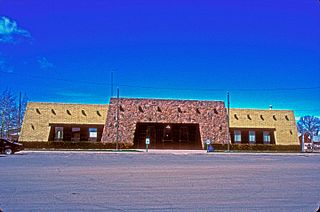
Conejos County is one of the 64 counties of the U.S. state of Colorado. As of the 2010 census, the population was 8,256. The county seat is the unincorporated community of Conejos.
The term The Black church refers to Protestant churches that currently or historically have ministered to predominantly African American congregations in the United States. While some Black churches belong to predominantly African-American denominations, such as the African Methodist Episcopal Church (AME), many Black churches are members of predominantly white denominations, such as the United Church of Christ.

The Cold Spring Presbyterian Church (www.coldspringchurch.com) is home to a congregation of worship and mission of the Presbyterian Church (U.S.A.) and West Jersey Presbytery that began in 1714, and continues to believe that everyone deserves to experience God's love in relevant and authentic ways. The thriving faith community began a community-focused transformational initiative in 2016. Cold Spring Presbyterian Church delivers spiritual resources and experiences that are centered in God’s love and proclaim the abundant life through Jesus Christ to make greater Cape May a better place through worship, activities, events, and other ministries.

Grace Community Church is a non-denominational, evangelical megachurch founded in 1956 and located in Sun Valley, a neighborhood in the San Fernando Valley of Los Angeles, California. Noted speaker and radio evangelist John MacArthur is the senior pastor of Grace Community Church. As of 2008, the average weekly attendance was 8,258.

First Baptist Congregational Church is a United Church of Christ and Baptist congregation currently located at 60 N. Ashland Blvd. in Chicago, Illinois, United States. The church building is an Illinois Historic Landmark and is listed on the National Register of Historic Places. The building was designed by architect Gurdon P. Randall for the Union Park Congregational Church, founded in 1860, and was built between 1869 and 1871. After the Great Chicago Fire of 1871, the Mayor's Office, City Council, and General Relief Committee of Chicago were temporarily headquartered in the church. In 1910, the building of nearby First Congregational Church burnt down. Union Park Congregational then merged with First Congregational to form (New) First Congregational Church. Two other congregations would eventually merged into the new First Congregational Church: Leavitt Street Congregational Church in 1917 and Bethany Congregational Church in the 1920s.

Guerdon Elmer Lowman, more familiarly G. E. Lowman was an American Christian clergyman and a pioneering international radio evangelist beginning in 1930, following a successful business career.

The former Temple Beth-El is a historic building located at 8801 Woodward Avenue in Detroit, Michigan. It was built in 1921 and listed on the National Register of Historic Places in 1982.
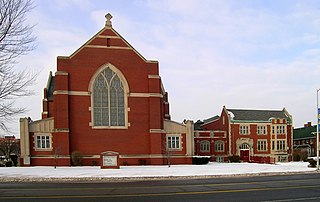
The St. John's Christian Methodist Episcopal Church is a church located at 8715 Woodward Avenue in Detroit, Michigan. It was built as the North Woodward Congregational Church, listed on the National Register of Historic Places in 1982, and designated a Michigan State Historic Site in 1998.
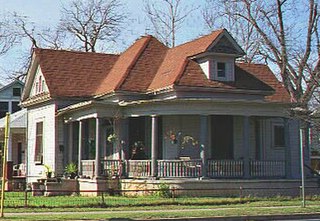
The Willow–Spence Streets Historic District is a neighborhood that lies east of downtown Austin, Texas. Its houses, churches, and commercial buildings were built in the early twentieth century. It is bounded roughly by Interstate 35 to the west, East César Chávez Street to the north, and Spence Street to the south. It extends a few houses east of San Marcos Street along Willow and Canterbury Streets. It thus includes portions of Willow, Spence, Canterbury, San Marcos, and Waller Streets. It was added to the National Register of Historic Places in 1985.

Bethel African Methodist Episcopal Church is located in Cedar Rapids, Iowa, United States. The congregation was established in either 1870 or 1871, which makes this the oldest historically African American church in the city. It had 23 pastors from its inception to 1928, which followed the African Methodist Episcopal Church's practice of itinerant pastors. The congregation grew slowly over this same period. Many African Americans came to Cedar Rapids after the coal industry in Southern Iowa began to collapse. The Rev. Benjamin Horace Lucas, who became pastor here in 1928, was also a catalyst for growth in the congregation. Completed in 1931, this brick Colonial Revival structure replaced a wood frame structure from 1876. Since its completion, it has served the social and religious needs of the community. It is one of the few surviving links to Cedar Rapid's early African American community as this neighborhood has been nearly obliterated by the development of Mercy Medical Center. The church building was listed on the National Register of Historic Places in 2013.

St. Joseph Catholic Church is a former Catholic parish in the Diocese of Davenport. Its former parish church is located in the west end of Davenport, Iowa, United States. It was listed on the National Register of Historic Places in 1983. The church and the rectory were listed together on the Davenport Register of Historic Properties in 1999. After serving as the location of a Reformed Baptist congregation and a private elementary school named Marquette Academy, the parish property now houses a fundamentalist Christian ministry named One Eighty.

The North American Lutheran Church (NALC) is a Lutheran denomination with over 420 congregations in the United States and Canada, counting more than 142,000 baptized members. As a Confessional Lutheran church, the NALC believes all doctrines should and must be judged by the teaching of the Christian Scriptures, in keeping with the historic Lutheran Confessions. It was established on August 27, 2010. The group describes itself as embodying the "theological center of Lutheranism in North America," noting that it stands between the more liberal Evangelical Lutheran Church in America (ELCA) and the more conservative Lutheran Church–Missouri Synod (LCMS) and other Lutheran church bodies in North America, "firmly within the global Lutheran mainstream".

Emmaus United Methodist Church, originally built as Calvary Methodist Episcopal Church, two of five names it has gone by in its existence, is located at Morris and West Lawrence streets in Albany, New York, United States. It is a brick Collegiate Gothic building constructed in the early 20th century. In 2008 it was listed on the National Register of Historic Places.

The 27th Street Historic District is a historic district in the South Los Angeles area of Los Angeles, California. The district was listed on the National Register of Historic Places in 2009 as part of the multiple property submission for African Americans in Los Angeles.
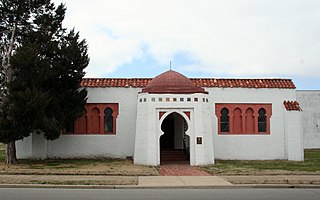
B'Nai Israel Synagogue is a historic Jewish synagogue at 126 S. Main in Cape Girardeau, Missouri.

Eckert Presbyterian Church previously known as First Presbyterian Church of Eckert is an historic church at 13025 Colorado Highway 65 in Eckert, Colorado.

Taylor Memorial Chapel at La Foret Conference and Retreat Center is a historic chapel in Black Forest, Colorado. It is a National Register of Historic Places listing.
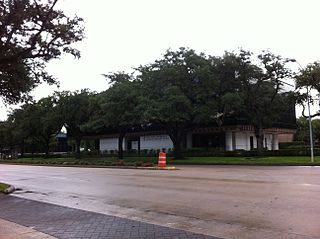
Christianity is the most prevalently practiced religion in the city of Houston, Texas. In 2012 Kate Shellnutt of the Houston Chronicle described Houston as a "heavily Christian city". Multiple Christian denominations originating from various countries are practiced in the city.
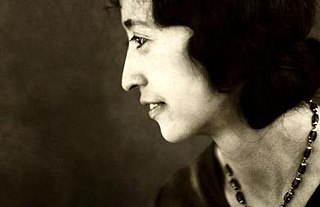
Erinea Garcia Gallegos (1903–2002) was an American educator and postmistress. Born in Conejos, Colorado, her family had deep roots in the region, being among the first settlers of the San Luis Valley that overlaps southern Colorado and northern New Mexico. She taught in elementary schools before her marriage and afterward served as postmistress of San Luis for nearly four decades. She was posthumously inducted into the Colorado Women's Hall of Fame in 2012.

Fitch Hall, at the New Mexico Institute of Mining and Technology in Socorro, New Mexico, was built in 1937. It was listed on the National Register of Historic Places in 1989.





















